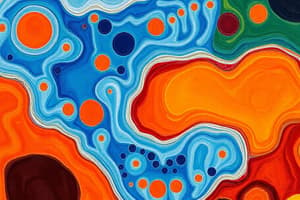Podcast
Questions and Answers
Which type of plant cell wall is characterized by high lignin content?
Which type of plant cell wall is characterized by high lignin content?
- Sclerenchyma (correct)
- Parenchyma
- Collenchyma
- Xylem (correct)
What type of spaces are formed within tissues as a result of cell separation or dissolution of cell walls?
What type of spaces are formed within tissues as a result of cell separation or dissolution of cell walls?
- Lysigenous Spaces (correct)
- Intercellular Spaces
- Schizogenous Spaces (correct)
- Extracellular Spaces
What type of tissue is primarily responsible for photosynthesis in plants?
What type of tissue is primarily responsible for photosynthesis in plants?
- Sclerenchyma
- Phloem
- Mesophyll (correct)
- Xylem
What is a common feature of permanent tissues derived from meristematic tissues?
What is a common feature of permanent tissues derived from meristematic tissues?
Which characteristic is true for sclerenchyma cells compared to parenchyma cells?
Which characteristic is true for sclerenchyma cells compared to parenchyma cells?
What is the primary significance of intercellular spaces in plant tissues?
What is the primary significance of intercellular spaces in plant tissues?
Which type of space is formed by the separation of cells due to the breakdown of cell walls?
Which type of space is formed by the separation of cells due to the breakdown of cell walls?
What is a notable characteristic of plant cell walls?
What is a notable characteristic of plant cell walls?
Which of the following is true about lysigenous spaces?
Which of the following is true about lysigenous spaces?
What distinguishes meristematic tissues from permanent tissues?
What distinguishes meristematic tissues from permanent tissues?
Flashcards are hidden until you start studying
Study Notes
Permanent Tissue
- Composed of differentiated cells.
- Can be simple (one cell type) or complex (multiple cell types).
- Cells can be living (Parenchyma, Collenchyma) or non-living (Sclerenchyma).
- Cytoplasm may be present or absent (Parenchyma contain cytoplasm, Sclerenchyma do not).
- Nucleus may be present (Parenchyma) or absent (Sclerenchyma).
- Cells are fully differentiated and do not divide further.
- Cells are larger in size than meristematic cells with varying shape and wide or narrow lumen.
- Cells may be loosely packed (Parenchyma) or tightly packed (Sclerenchyma).
- Living cells have vacuoles, dead cells are devoid of protoplasm.
- Cells have low or no metabolic activity.
- Cell wall can be cellulosic (Parenchyma, Collenchyma) or lignified (Sclerenchyma).
- Secondary thickening may occur.
- Lignified secondary cell walls may be present, particularly in Sclerenchyma.
- Cells have advanced pits.
- Cells contain various ergastic substances and cellular inclusions.
- Some cells store reserve food materials such as starch.
- Derived from meristematic tissues.
- Found throughout the plant body (examples: Xylem, Phloem, Mesophyll).
- Functions vary depending on the tissue type and include conduction, support, and photosynthesis.
Meristematic Tissue
- Composed of undifferentiated cells.
- Always simple tissue, composed of only one cell type.
- Cells are always living.
- Cells have densely packed cytoplasm.
- Prominent nucleus always present.
- Cells rapidly divide.
- Cells are smaller and isodiametric with a large lumen.
- Cells are tightly packed with no intercellular spaces.
- Cells lack vacuoles.
- Cells have high metabolism.
- Cell wall is thin and cellulosic.
- Cells do not undergo secondary thickening.
- Lignified secondary cell wall completely absent.
- Cells only contain primary pit fields.
- Cellular inclusions and ergastic substances are absent in the cells.
- Cells do not store reserve food materials.
- Responsible for producing permanent tissues.
- Found in specific parts of the plant body (examples: root apex, shoot apex).
- Primary function is to help in plant growth.
Studying That Suits You
Use AI to generate personalized quizzes and flashcards to suit your learning preferences.



